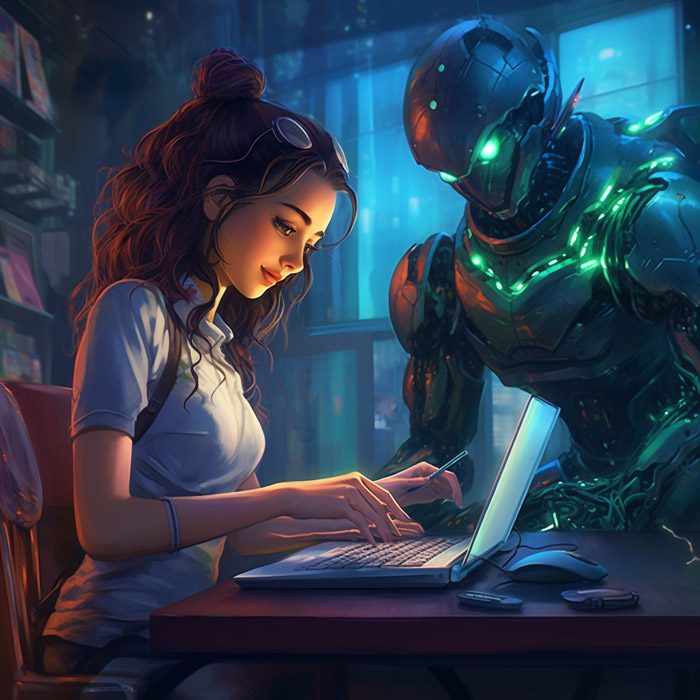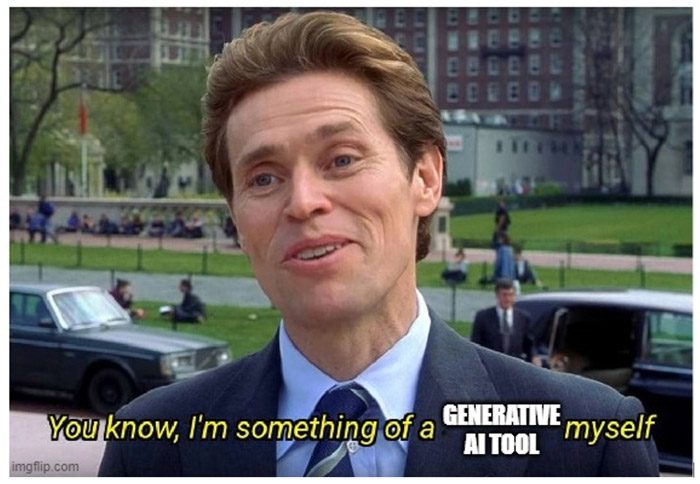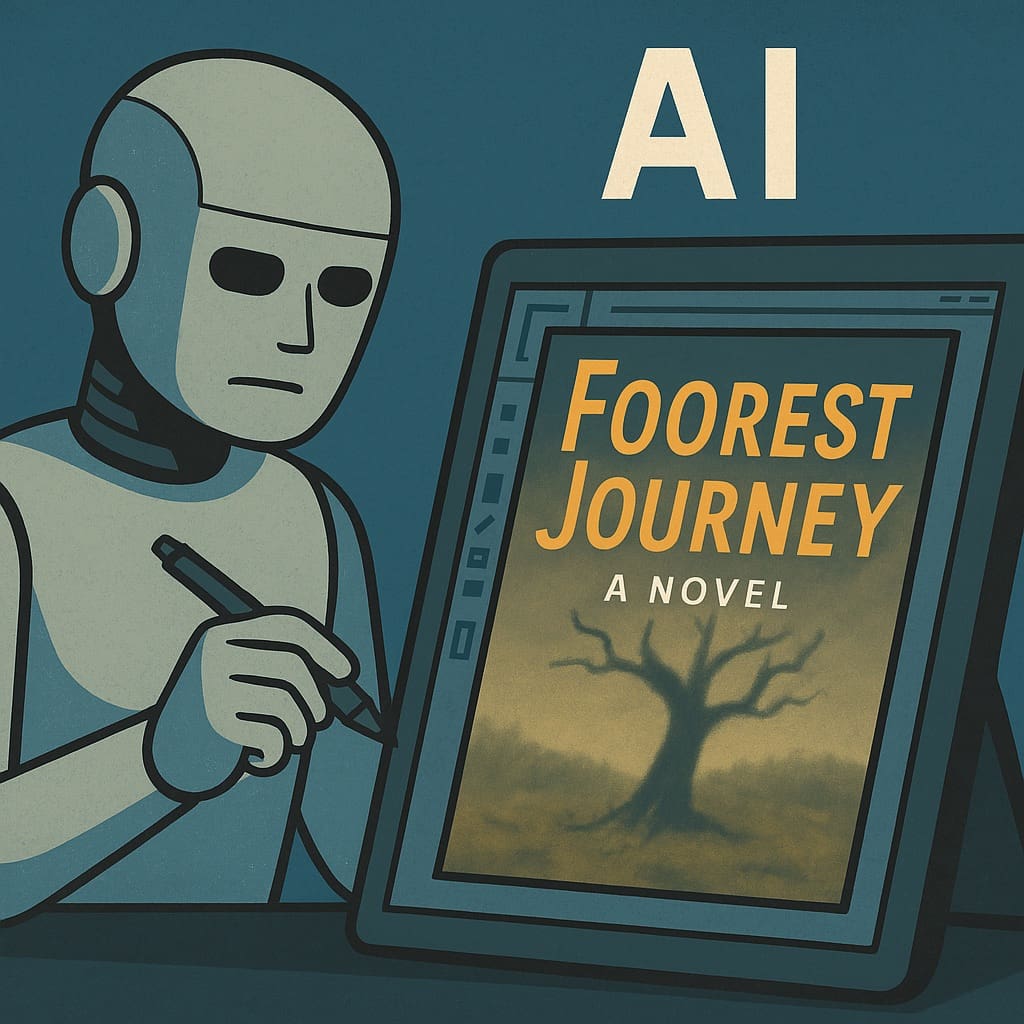As a book cover designer, I like to think I have a bond with other professional creatives, whether writers, designers, musicians or that guy who duct-tapes bananas to a wall and charges $120,000 for the soon-to-be overripe art. Perhaps we share less of a bond. Like second cousins.
What binds creatives is the act of making a living from unique things that fall from our brains. You pour your heart into the creation process, crossing fingers and toes that people will like what you produce, and feeling warm and fuzzy when they do.
This is what makes the rise of generative AI so odd, and potentially so icky, to so many artists. Art shouldn’t be created by pressing a button, or so the thinking goes. As I’ve mentioned earlier in this series of articles, it’s a thought that I’ve wrestled with myself.
But after months of research and reflection, I’ve decided that Damonza should embrace AI as part of book cover design.
In this article I’d like to take you on my journey and explain how I’ve settled on this position. I’d like to take the opportunity to address the concerns and dispel the fears that many, including myself, have felt toward generative AI.
Fad? Handy tool? Bare-faced plagiarist? Existential threat? Here are my thoughts and feelings.
Does generative AI plagiarise artistic works?
One of my first realisations is that AI is not some sort of superpowered plagiarism machine. It doesn’t copy art, nor does it take elements from art and stitch them together. It produces new things.
Run text from ChatGPT through a plagiarism checker and it will pass with flying colours. Create an image in Midjourney and conduct a reverse search on Google Images, and you’ll find that no part of it has ever existed before.
Generative AI doesn’t plagiarise. It learns from old art to create new art, which is how art has always worked.
When the Roman Empire fell in the 5th century, its art was largely lost to the sands of time. While the Medieval art that followed gave us some unquestionably fantastic cats, by the 15th century people were ready for something new. Classical Roman culture and art was rediscovered, birthing the Renaissance. Soon every self-respecting Italian painter took healthy inspiration from both the Romans and contemporary Renaissance artists.
On and on it went. Impressionism, surrealism, pop art; each new style turned old into new, and each new artist looked around to see what others were doing.
Pablo Picasso knew the score. He and his friend Georges Braque are credited with inventing cubism, one of the few styles that art historians think of as an entirely new visual idiom. But when another Catalan artist, Salvador Dali, began to produce cubist paintings two decades after the style was established, Picasso felt no animosity.
“Good artists borrow, great artists steal,” were his simple thoughts (ironically this quote may have taken healthy inspiration from the works of T.S. Eliot).
Like human artists, generative AI tools learn styles and techniques, then use what they have learnt to make something new, and you can’t copyright style. But unlike human artists, AI can learn all the styles and techniques, because it studies a functionally infinite database of images.
But what about training AI on copyrighted work?
Perhaps the most prevalent concern amongst creatives is the ethics of training generative AI on copyrighted works. It’s an issue that has come to a head in the last two years. In 2023 and 2024, lawsuits were filed against companies like Stability AI, OpenAI, and Midjourney, with plaintiffs including artists, stock photo agencies, and even authors.
For their part, the creators of generative AI tools have argued that the datasets were covered under fair use, citing legal precedent around data mining and transformative use. However, as of 2025, the legal landscape is still in flux. Some U.S. courts have allowed portions of these cases to proceed, but no definitive ruling has yet clarified whether training on copyrighted material without permission violates existing copyright law.
In parallel, efforts like Spawning and Have I Been Trained are giving artists more visibility and control over whether their work is used in future training datasets. Tools are improving, but the ethics remain murky.
As a fellow creative – and strap yourself in for a hot take here – I feel as though that consensus may be misguided.
As a cover designer, authors often send me covers they like and ask me to do something similar. They send me links to Pinterest pages full of copyrighted images to inspire or guide my thinking, photos of actors to base a character on, and existing covers or movie posters to train me on what they want. I also have my own Pinterest page full of covers I admire that I sometimes refer to when coming up with new cover designs of my own. Over the years I’ve trained myself by looking at thousands, perhaps even millions (it feels like) of book covers, and I’ve learned the elements that make up an effective cover design.
If I wanted to learn cubism, I’d study Picasso’s paintings, so all in all:
But if I simply copied one of Picasso’s works and told people the canvas was a Picasso – admittedly a long shot – I would have crossed a line. And in the wrong hands, any creative tool, from a paint brush to an AI image generator, can be used in unethical ways. Sure, AI certainly makes these unethical actions quicker and easier, but that doesn’t make the tool itself unethical. AI learns from other art, other artists, then creates something new. It simplifies and speeds up the process of making art. Can people use it for questionable purposes? Sure. But scanners, existing software, and printers can be used for questionable purposes too. Why are there no lawsuits against Photoshop?
Both humans and generative AI tools learn from existing copyrighted works without permission. So I ask myself a question: if there is a difference between a human and a computer doing it, what exactly is it?
The good news is that while the judicial system does its best to answer this question, artists aren’t powerless. Ironically, AI-driven services are popping up to help their cause. Spawning, for example, allows artists to check whether their work has been used to train AI, and gives them the opportunity to opt out of public training datasets.
The toothpaste won’t go back in the tube
Hopefully my thoughts above don’t paint me as a heartless, artist-hating tech bro. I’m a creative, and I feel for creatives who this technology may negatively affect. No one deserves to have their art appropriated, and everyone deserves to get fair recompense for their hard work.
It’s why the following condition forms a key part of the Damonza Generative AI Image Policy:
“No real people or artists are used as part of the prompts.”
We will never directly replicate the style of another creative or use the likeness of a famous individual or brand. Even if you really want an AI-generated image of a banana duct-taped to a wall, I’m afraid we’ll have to politely decline. We will instead use a mixture of our own creativity and general style prompts to create the elements that feature on our book covers.
Why have we chosen to utilise generative AI while some ethical ambiguity remains? Two reasons:
-
1. Because we can create rules, like the one above, to ensure we use it in the right way.
-
2. Because this particular genie is not going back in the bottle.
The new beta version of Adobe Photoshop, the most important tool in any visual artist’s toolkit, now has generative AI built in. There’s no going back, and it’s up to us to evolve as technology evolves.
We also recognise that in terms of book cover design, this technology has incredible potential.
We want to be the best book cover designers we can be. We want to design covers that exceed the author’s expectations, and that are a perfect encapsulation of the books they wrap. And we want to use all the tools that are available to us in this quest.
Think about when CGI technology became accessible for the film industry. Sure, we could still be making movies with puppets and expensive sets, but CGI makes the process far more efficient and cost-effective. Were puppet makers and set designers negatively affected? Yes. Were visuals better? Also yes (as long as we all agree that the 2019 motion capture remake of Cats never happened.)
And just like certain movies, from Toy Story to Interstellar, could not be made without CGI, some of the covers we are now producing could not be made without generative AI.
The entry of new and truly disruptive technologies is never all sunshine, lollipops and rainbows. But generative AI is a technology that can take us closer to our goal of creating the very best covers we can.
Embracing generative AI at your own pace
Authors, like cover designers, are professional creatives, and to many it will feel wrong to delegate any part of the creative process to a machine, no matter how impressive the results might be.
So if you don’t want to use it, you don’t have to. We offer all customers the opportunity to opt out of using generative AI in their cover* – simply tick a box on the order form. If it gives you the ick, we give it the kick.
But if you’re brave enough to lean into it, you might be surprised at just how beneficial this technology can be. Indeed, that subject will be the focus of our final piece in this four-part series: the extensive and often surprising perks of using AI in cover design.
*As AI becomes more ubiquitous, as we’ve already seen in Photoshop, avoiding it will become more challenging. Rest assured we will always be transparent in how we use the technology.







2 Responses